

Tullichewan is a former estate in the Vale of Leven, near Loch Lomond, Scotland. Tullichewan Castle was built in 1792 and demolished in 1954. It was located on the western edge of Alexandria, close to the present route of the A82.


Tullichewan is a former estate in the Vale of Leven, near Loch Lomond, Scotland. Tullichewan Castle was built in 1792 and demolished in 1954. It was located on the western edge of Alexandria, close to the present route of the A82.
Originally called Tuloch Eoghain, "the hill of Eoghan." In the 17th century it was acquired by the Colquhoun family, and was known as Tully-Colquhoun or Tillyquhoun; and then Tullichewan. The Tullichewan estate was sold by the Colquhoun clan to James Buchanan in 1792.
Tullichewan Castle was designed in 1792 by architect Robert Lugar, who also designed Balloch Castle. It is the first example in Scotland of an asymmetrical Gothic house. The Horrocks family purchased the castle in 1817, living there until 1843. The estate was then sold to William Campbell of J & W Campbell, Glasgow merchants and remained in the Campbell family until the twentieth century. [1]
The last owner was J Scott Anderson who acquired the house around 1930. [2] At the outbreak of World War II, Tullichewan Castle Estate was requisitioned by the Royal Navy, who retained it for the rest of the war. Tullichewan Castle Camp was put to various uses. [3] After the war, it was used as accommodation for workers at the Royal Naval Torpedo Factory in Alexandria. [2] After the war, Mr J Scott Anderson returned to live in the castle, until its upkeep became too much. The castle then lay abandoned until it was finally demolished by explosives in 1954. [3]
Although modern development has consumed most of the former estate, and little remains, a number of remnants are reported to have survived. [2] The A82 dual carriageway and the A811 road were built through the grounds, with housing developments and the Vale of Leven Hospital covering the estate. The former stables and a fragment of the original tower can still be seen from the A82. The north lodge, or gatehouse, has been lost in the area of Tullichewan Caravan Park, where the estate also had a walled orchard. The south lodge can still be found on Main Street, Alexandria, north of the entrance to Christie Park. Of the Camp, no trace remains.

Alexandria is a town in West Dunbartonshire, Scotland. The town is on the River Leven, three miles north of Dumbarton and 15 mi (24 km) north-west of Glasgow.
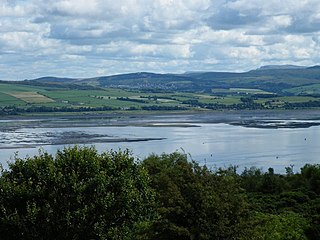
The Vale of Leven is an area of West Dunbartonshire, Scotland, in the valley of the River Leven. Historically, it was part of The Lennox, the name of which derives from the Gaelic term Leamhnach, meaning field of the Leven. Leamnha is thought to mean elm-water.
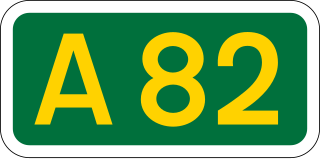
The A82 is a major road in Scotland that runs from Glasgow to Inverness via Fort William. It is one of the principal north-south routes in Scotland and is mostly a trunk road managed by Transport Scotland, who view it as an important link from the Central Belt to the Scottish Highlands and beyond. The road passes close to numerous landmarks, including Loch Lomond, Rannoch Moor, Glen Coe, the Ballachulish Bridge, Ben Nevis, the Commando Memorial, Loch Ness, and Urquhart Castle. Along with the A9 and the A90 it is one of the three major north–south trunk roads connecting the Central Belt to the North.

Dumbarton is a town in West Dunbartonshire, Scotland, on the north bank of the River Clyde where the River Leven flows into the Clyde estuary. In 2006, it had an estimated population of 19,990.

Vale of Leven Football Club is a Scottish football club based in the town of Alexandria, in the Vale of Leven area of West Dunbartonshire. Nicknamed "the Vale" and formed in 1939, the club competes in West of Scotland League Third Division, the ninth tier of Scottish football, holding home games at Millburn Park.

Balloch is a village in West Dunbartonshire, Scotland, at the foot of Loch Lomond.

Renton is a village in West Dunbartonshire, in the west Central Lowlands of Scotland. In the 2001 National Census it had a population of 2,138.

Inchmurrin is an island in Loch Lomond in Scotland. It is the largest fresh water island in the British Isles.

The River Leven is a stretch of water in West Dunbartonshire, Scotland, flowing from Loch Lomond in the North to the River Clyde in the South. The river is about 6 miles long. It is very popular with salmon and sea trout anglers, trying to catch one of these migratory fish going up to Loch Lomond.

Bonhill is a town in the Vale of Leven area of West Dunbartonshire, Scotland. It is sited on the Eastern bank of the River Leven, on the opposite bank from the larger town of Alexandria.

Harviestoun is an estate in Tillicoultry parish, Clackmannanshire, central Scotland. It lies at the base of the Ochil Hills, around 1.5 kilometres (0.93 mi) east of Tillicoultry and 2 kilometres (1.2 mi) west of Dollar.

Duntrune Castle is located on the north side of Loch Crinan and across from the village of Crinan in Argyll and Bute, west of Scotland. It is thought to be the oldest continuously occupied castle on mainland Scotland. It was the seat of the Campbells of Duntroon until 1792. The castle is a category B listed building.
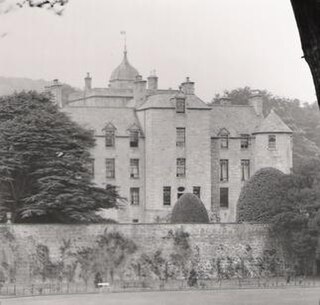
Haltoun House, usually known as Hatton House,, was a Scottish baronial mansion set in a park, with extensive estates in the vicinity of Ratho, in the west of Edinburgh City Council area, Scotland. It was formerly in Midlothian, and it was extensively photographed by Country Life in September 1911.

Mordington is an agricultural parish in the extreme south-east of Berwickshire in the Scottish Borders region. It is five miles from Berwick-upon-Tweed and borders Northumberland to the east, and south, Foulden to the west, and Lamberton to the north. The parish is bisected by the A6105 Berwick to Duns road. The lower part of the parish is covered by the Edrington estate. It is possibly the warmest parish in Scotland; the annual hours of sunshine are said to be almost as high as at Dunbar, which records the most hours in Scotland.

Strachur and Strathlachlan are united parishes located on the Cowal Peninsula, in Argyll and Bute, west of Scotland. Strachur is a small village on the eastern coast of Loch Fyne.
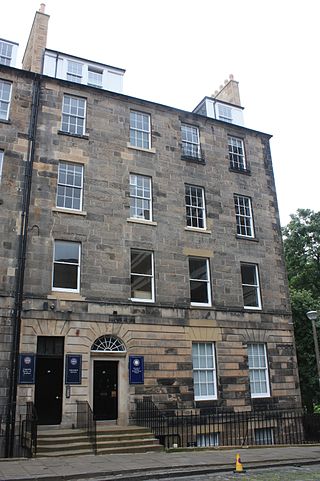
John Paterson was a Scottish architect who trained with Robert Adam (1728–1792) whom he assisted with his work on Edinburgh University Old College and Seton House Castle.
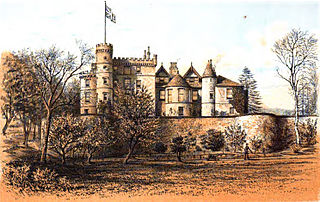
Ardencaple Castle, also known as Ardincaple Castle, and sometimes referred to as Ardencaple Castle Light, is a listed building, situated about 1 statute mile (1.6 km) from Helensburgh, Argyll and Bute, Scotland. Today, all that remains of the castle is a tower, perched on the edge of a plateau, looking down on a flat tract of land between it and the shore of the Firth of Clyde. The original castle was thought to have been built sometime in the 12th century, and part of the remains of the original castle were said to have existed in the 19th century. Today, that sole remaining tower is used as a navigational aid for shipping on the Firth of Clyde. Because of its use as a lighthouse the tower has been called Ardencaple Castle Light.

Vale of Leven Academy is a non-denominational secondary school in West Dunbartonshire, Scotland. The school serves the surrounding towns of Alexandria, Balloch, Bonhill, Jamestown, and Renton. The current school building, opened in June 2009, has a capacity for approximately 1,100 pupils.
The 1883 Scottish Cup final was the 10th final of the Scottish Cup and the final of the 1882–83 Scottish Cup, the most prestigious knockout football competition in Scotland. The original match - which ended in a 2–2 draw - was played at Hampden Park in Crosshill on 31 March 1883 and was watched by a crowd of 15,000 spectators. For the first time in the competition's history, the final was contested by two teams from outside Glasgow - Dumbarton, who had never won the cup before, and three-time winners Vale of Leven.